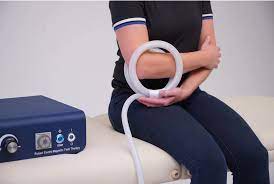Isgoyska firfircoon ee qaab dhismeedka iyo daryeelka caafimaadka, Isku-dhafka isku-dhafka ah wuxuu ka soo baxayaa is dhexgalka Daaweynta PEMF ee ciyaartooyda Naqshadeynta qaab dhismeedka. Arqalqadeeyadu waxay sii kordhayaan tikniyoolajiyadda caafimaadka ee dhismayaasha si kor loogu qaado samaqabka iyo natiijooyinka caafimaadka ee deganeyaasha. Qaabkan wax-ku------curinta ah kaliya kama tarjumayso isbeddelka bulshada ee bulshada laakiin sidoo kale waxay muujineysaa doorka dhismaha ee kobcinta jawiga caafimaadka. Maqaalkani wuxuu sahamiyaa isgoyska qaab dhismeedka iyo qalabka caafimaadka, muujinaya tusaalooyinka muhiimka ah iyo saameynta suurtagalka ah ee mustaqbalka.
- HALKAN HOOSE-CARRUURTA:
Qareenka naqshadeeye ayaa dib u qeexaya fikradda ah qaab dhismeedka fayoobaanta ee isku-darka aaladaha caafimaad ee kor u qaadaya caafimaadka iyo kor u qaadida wanaagga guud ee deganeyaasha dhismaha. Qaabkan ayaa ka baxsan mabaadi'da naqshadaha dhaqameed ee dhaqanka, diiradda saaraya abuurista meelo badan oo si firfircoon gacan uga geysaneysa caafimaadka jirka iyo maskaxda ee shakhsiyaadka.
- Dhismooyinka caqliga leh iyo kormeerka caafimaadka:
Soosaarida tikniyoolajiyadda dhismaha ee Smart-ka ee Smart-ka ayaa jidka u furtay isku darka qalabka caafimaadka ee lagula jiro kormeerka caafimaadka. Laga soo bilaabo dareemayaasha cabbiraya tayada hawada ee aaladaha la isku darka leh ee lagu daro kaabayaasha dhismaha, Arqalqadeeyayaashu waa qaab dhismeedka qaab dhismeedka si firfircoon ula soconaya cabbirrada caafimaad ee deggeneyaasha. Ururintan waqtiga-dhabta ah waxay ku siin kartaa aragtiyo qiimo leh wanaaga shaqsiyaadka waxayna gacan ka geysan kartaa daryeelka kahortaga caafimaadka.
- Jawiga laqabsashada:
Naqshadeynta naqshadeynta qaab dhismeedka ayaa noqda mid laqaban karo, Ka jawaabista baahiyaha shaqsiyaadka leh xaalado caafimaad oo gaar ah. Tusaale ahaan, Dhismooyinka waxaa lagu qalabeyn karaa tikniyoolajiyad si ay uga caawiso shakhsiyaadka caqabadaha dhaqdhaqaaqa ama dareemayaasha dareenka. Qaabkan naqshadeynta loo dhan yahay ayaa loogu talagalay in lagu abuuro jawilo u gudbiya baahiyo kaladuwan oo daryeel caafimaad ah.
- Qaab dhismeedka isbitaalka iyo is dhexgalka qalabka caafimaadka:
Xarumaha daryeelka caafimaadka ee dhabta ah, Arqalqadeeyayaashu waxay si dhow ula shaqeynayaan xirfadlayaasha caafimaad si ay si aan kala go 'lahayn ugu dhexgalaan qalab caafimaad oo khaas ah naqshadda. Tan waxaa ka mid ah nidaamyada sawirka sare ee horumarsan, Robotics-ka qalliinka, iyo kaabayaasha teleledicine. Hadafku waa in kor loo qaado hufnaanta daryeelka daryeelka caafimaad inta la abuurayo jawi bukaan-jiifka iyo taageerada taageera.
- Naqshadeynta naqshadeynta basaasiyadda iyo jawiga bogsashada:
Isku-darka mabaadii'da naqshadaynta basaasiyadda, kuwaas oo carrabka ku adkeeya xiriirkii dabeecadda, waxaa dhameystiraya aalado caafimaad oo gacan ka geysata bogsashada jawiga. Tusaale ahaan, Naqshadeynta naqshadeeyadu waxay dhexgelin karaan nidaamyada nalalka ee iftiinka qoraxda ee dabiiciga ah si kor loogu qaado heesaha wareega, si togan oo si togan saameyn ugu yeela’ Ka soo kabashada goobaha daryeelka caafimaadka.
- Cilmi baarista iyo iskaashiga horumarinta:
Sida is dhexgalka aaladaha caafimaad ee naqshadeynta naqshadeeyayaasha qaab dhismeedka ay noqdaan kuwo aad u badan, Arqalqadeeyadu waxay sii kordhayaan iskaashi ay la leeyihiin cilmi-baarayaasha caafimaadka iyo soo-saareyaasha aaladda. Wada-hawlgalayaashan is dhexgalka ah ee kobcinta kobcinta, taasoo horseedaysa abuurista qaab-dhismeedka aan ku taageerin oo keliya caafimaadka dadka laakiin waxay sidoo kale gacan ka geysaneysaa horumarka tikniyoolajiyadda caafimaadka.
- Caqabadaha iyo tixgelinta anshaxeed:
In kasta oo is dhexgalka Daaweynta PEMF ee ciyaartooyda Naqshadeynta naqshadeeya qaab dhismeedka ayaa leh ballanqaad weyn. Waxay sidoo kale kor u qaadaa caqabadaha iyo tixgelinta anshaxeed. Arrimaha la xiriira asturnaanta, Amniga xogta, iyo si xun u isticmaalka macluumaadka caafimaad ee si taxaddar leh wax looga qabto. Naqshad, Xirfadlayaasha daryeelka caafimaadka, khubarada tikniyoolajiyaddana waxay u baahan yihiin inay ka wada shaqeeyaan sidii loo dhisi lahaa. Tilmaamaha anshaxeed ee is dhexgalka mas'uuliyadda ee aaladaha caafimaad ee deegaannada dhistay.
Gabagabo:
Isku-darka qaab dhismeedka iyo Daaweynta PEMF ee ciyaartooyda waxay matalaysaa isbedel isbadal. U beddelo habka aan u fikirinno oo aan naqshadeeno meelaha aan ku noolaano iyo daryeel caafimaad. Laga bilaabo dhismayaasha caqliga leh ee si firfircoon ula soconaya caafimaadka ee naqshadaha cosbitaalka ee si aan kala go 'lahayn ugu darista qalabka caafimaad ee horumarsan. Arqalku waa safka hore ee abuurista jawiyo ah oo mudnaanta siiya wanaagga deganayaasha. Maaddaama isbeddeladaasi uu sii wado horumarka, Waxay muhiim u tahay xirfadleyda oo dhan si loo wada shaqeeyo. Hubinta in hal-abuurkaasi ay si togan ugu biiriyaan caafimaadka iyo farxadda shaqsiyaadka iyagoo wax ka qabanaya tixgalinta anshaxeed. Mustaqbalka dhismaha ee loo yaqaan 'Arccittured' kuma eka oo kaliya suuxinta iyo waxqabadka. Laakiin awooda ay si firfircoon uga qeyb qaadanayso hagaajinta caafimaadka aadanaha iyo tayada nolosha.

